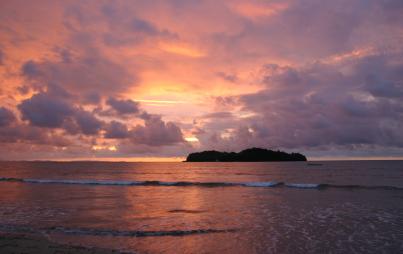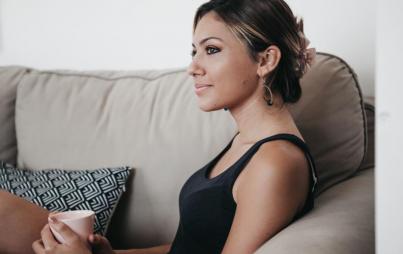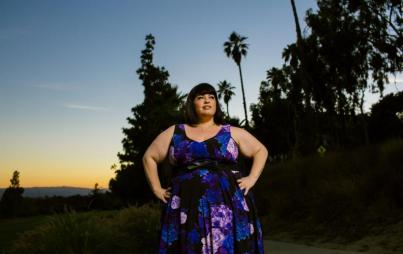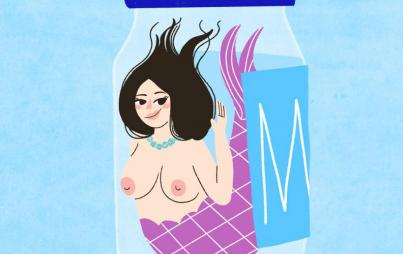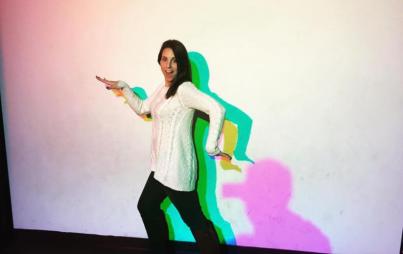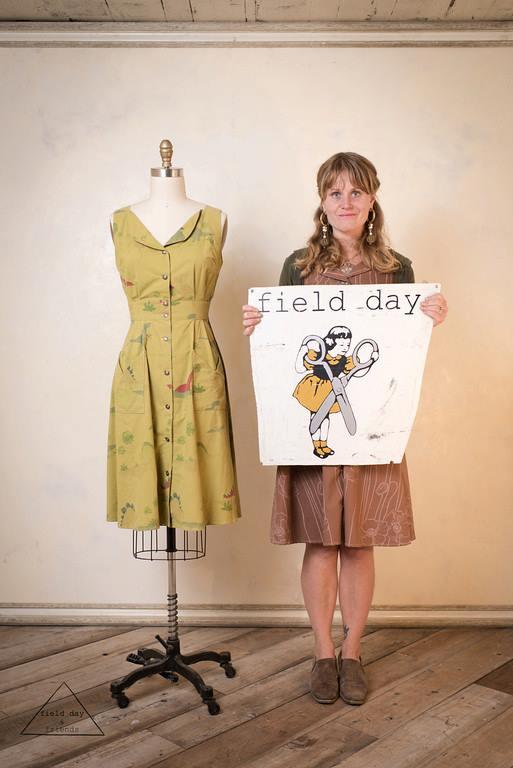
In what many consider a utopian world, we would live a slower life, grow our own food and wear sustainable clothing. We would claim lost things, help other people and strive to make our life's work flourish. If this sounds difficult, it's because it is. But that doesn't stop Trinity Cross, founder of sustainable clothing company Field Day, from working around the clock to make her own dreams come true.
The Field Day line includes reused and sustainable fabrics in every piece of clothing. Each dress is handmade and designed to flatter any and all feminine shapes, and every item is built for comfort, whether when exercising, working or bar-hopping. And Cross's store isn't called Field Day and Friends just for the heck of it: She also features a new artist and designer each month, and has over 80 maker friends who sell their handmade wears in her store.
I went to the Field Day and Friends shop on 19th street in Oakland to see what Cross was up to, and to chat with her about Field Day and her talented Friends.
Field Day and Friends is a brick and mortar shop that also houses your studio. What do you make here?
I started doing everything myself. Just in the last four years I’ve had other people sew for me, and then in the past year I've added staff to help run both the shop and the clothing line.
I also hired a pattern maker; I do all the designing and the sketching, then I give it to here. She makes the patterns, and then I have a garment factory that I use that’s like four blocks away from here. I take all my stuff there to get sewn.
I do very minimal stuff here now; I do some fixing things, some tailoring. I sew the suspenders and sometimes I get inspired to just sew something up and see if I want to use it for a design. But I’m actually employing other people in Oakland right now who are doing a lot of the work.
Are you growing quickly?
I’m not growing quickly; I would say slowly and steadily, which is how I like it. Too fast means too much stress. It’s hard to be sustainable and not run out of resources when you’re progressing too quickly. I think slow and steady wins the race.
Your website says that you use the most sustainable materials available. Can you expand on what that entails?
I hunt through a lot of different fabrics, which means that a lot of my stuff is very small batch; there's a lot of one-of-a-kind or very small runs. I’m always looking for materials, which is good because I’m addicted to thrift store shopping. It fills my modern hunter-gatherer instincts.
We use a lot of bedsheets. My most popular design is a bedsheet dress and a bedding dress. We use sheets that I thrift and hunt for, some of which are dyed, and some of which I leave as is. We also use organic cotton that is grown and milled in the U.S., and we use deadstock materials.
How many dresses does a bedsheet make?
One dress for a bedsheet, two for a duvet.
What is deadstock?
Materials that are left over from big fashion houses that aren’t used for some reason, or the vintage stuff that’s resurfaced.
What is your favorite material to work with?
I love working with the bedsheets just because it’s so one-of-a kind, it really makes the dress. The fabrics that they’re made out of have a really high thread count, generally. And they don’t wrinkle. A lot of them I only find one time—and then there’s the ones that I find a lot of that I make over and over. But a lot of them, especially the vintage ones, are really soft and worn in.
I just like the stories behind it; you never know where they came from, so the fact that people have made babies and slept and dreamed on them adds a story to them that's really kind of cool.
Where do you go to search for the materials you use—both for your Field Day line and for the brick and mortar shop?
Well, I’m a thrift store junkie so I go to thrift stores a lot. Also flea markets, yard sales. And I’m gifted things. People know my esthetics so I have people looking out for bedsheets all the time, so that’s really nice.

Everything in the store is hand made. We have regulars like FoxTale Fanny; she’ll probably be in the store until we close. She’s a good friend of mine and her stuff sells really well. I try and rotate things out but the people who are selling really well, obviously I keep in the store.
I have a rack in the shop just for the featured designer and that rotates out monthly. So every First Friday in Oakland, we feature a new designer and a new artist. I hire a photographer and have a photo booth where if you get your portrait taken you get 10% off. I use those photos and post them on Facebook so people can see what different body types look like in the dresses. It’s good for marketing and people can find out about us. We try and have snacks and wine for people.
You’re online at FieldDayWearables.com, Etsy, ECOenstyle and Fielddayandfriends.com, and have products in states all over the country . . .
I have a bunch of retail locations that sell Field Day. It’s a mixture of both; some people find out about me through other people, and some people find out about me through pop-up shops and street fairs. Sometimes a friend or a shop owner will come and say, 'Hey, your stuff would do really well at this store.' Ideally I contact them and they’re like, 'Oh yeah, that would be great.'
I also have my 'Warrior'; it’s a ‘91 Toyota Winnebago that I converted into a mobile storefront. So I just went up to the Northwest and I stopped at a bunch of stores that had expressed interest in selling my stuff. It’s fun. I have my bed in there so I have a little house/store.
You were telling me that you also have some property and that you have been working on an urban farm there. Can you talk more about that?
My neighbor and I bought our two houses and our yards connect and then we have two lots next to us. We didn’t buy the lots; one of them we’re squatting and the other we’re renting. We have chickens, fruit trees and some veggie beds. I also have a fish pond that I use to make compost to fertilize the garden. The fish poop is a good nitrogen-based fertilizer.
What is your favorite part of having a farm and a successful sustainable company?
I really like to see things grow. I really like to see how my input and what I have done has helped things thrive. So when I can see that my work has made someone happy, that fills me with happiness.

Your dresses are based on the classic silhouette. Is there a reason for it?
We like to feature the female form and the high waist. We want to make sure women feel comfortable; we believe looking good is feeling good. Being able to eat a sandwich, drink a beer, take a deep breathe, move around, be active, ride a bike, dig in the dirt (I wear my dresses gardening all the time)—that's all important. And we have lots of pockets so you can be functional. Functional dresses that look good! We like being feminine, but we also like to get dirty.
I think getting dirty makes you look good. It shows you’re capable. I think capability is really attractive.
Do you have any new projects that you’re working on?
I’m working on my fall line right now, getting it out. I just got all the patterns ready and I just need to grade them. I’m not printing anymore, so I’m finding a lot of fabrics that already have prints that I like. There’s always something new happening with the featured artists.
Do people come to you to be featured?
I have people come to me, and if someone recommends someone to me, then I’ll reach out and tell them they’ll be featured for a month and at Oakland's First Friday event.
I like to work with a lot of emerging artists and designers because it’s exciting, it’s new, it gives people an opportunity to expand and I can help people bust in. People are more grateful when they’re new and emerging. If there’s a newness to it, it creates more buzz and excitement. Also a lot of people I work with are my friends.
What's it been like to see your dream actualized?
It’s pretty rewarding. I try not to let ego step in, and I’m really bad at getting compliments, so I have been trying to embrace that. It feels really good. In the past year I’ve been able to take a moment to reflect and be like, 'Wow, it’s happening.' Oakland as a city has been an amazing piece of it; I don’t know if it would work in any other city. I’m really grateful to my city and my friends.
There’s no way I could have done this without help from my friends. I would just be crying in a puddle on the floor.
The journey is really scary at first. It’s really hard when you create something and you have to teach someone to think like you. It’s like, I know what to do. but how do I train somebody to think like me? That’s been a little bit difficult, but it’s totally doable. It just takes a little patience and good communication.
You’re from Oregon originally. Did you move here to do Field Day? 
Yeah, I was living in Asheville, North Carolina, and I decided that I wanted to come back to the Bay and go to fashion school. I only stayed in for a year. I wanted to learn how to drape, draft and sew correctly. I wanted to do it with clean lines and finished hems. I got what I needed out of it and then I left. I opened a community-based print shop with my brother. It’s a silk screen shop that’s fully functional. Anyone can become a member for $100/month and have it as their print shop. It’s called Patchwerk Press.
Do you ever get time away from working? What do you like to do to unwind?
I have actually! We have been open for a year and a quarter, and after the first year I feel like I have kind of been able to step away. Hiring Taylor as a manager has been really helpful. I’m kind of on my five-year plan to move to the country. I want a homestead in the country so I’m focusing on that, spending more time in the woods, specifically up north outside of Redding and Big Bend.

